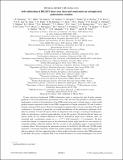Self-calibration of BICEP1 three-year data and constraints on astrophysical polarization rotation
Author(s)
Su, Meng
DownloadKaufman-2014-Self-calibration of BICEP1.pdf (581.4Kb)
PUBLISHER_POLICY
Publisher Policy
Article is made available in accordance with the publisher's policy and may be subject to US copyright law. Please refer to the publisher's site for terms of use.
Terms of use
Metadata
Show full item recordAbstract
Cosmic microwave background (CMB) polarimeters aspire to measure the faint B-mode signature predicted to arise from inflationary gravitational waves. They also have the potential to constrain cosmic birefringence, rotation of the polarization of the CMB arising from parity-violating physics, which would produce nonzero expectation values for the CMB’s temperature to B-mode correlation (TB) and E-mode to B-mode correlation (EB) spectra. However, instrumental systematic effects can also cause these TB and EB correlations to be nonzero. In particular, an overall miscalibration of the polarization orientation of the detectors produces TB and EB spectra which are degenerate with isotropic cosmological birefringence, while also introducing a small but predictable bias on the BB spectrum. We find that Bicep1 three-year spectra, which use our standard calibration of detector polarization angles from a dielectric sheet, are consistent with a polarization rotation of α = −2.77° ± 0.86° (statistical) ± 1.3° (systematic). We have revised the estimate of systematic error on the polarization rotation angle from the two-year analysis by comparing multiple calibration methods. We also account for the (negligible) impact of measured beam systematic effects. We investigate the polarization rotation for the Bicep1 100 GHz and 150 GHz bands separately to investigate theoretical models that produce frequency-dependent cosmic birefringence. We find no evidence in the data supporting either of these models or Faraday rotation of the CMB polarization by the Milky Way galaxy’s magnetic field. If we assume that there is no cosmic birefringence, we can use the TB and EB spectra to calibrate detector polarization orientations, thus reducing bias of the cosmological B-mode spectrum from leaked E-modes due to possible polarization orientation miscalibration. After applying this “self-calibration” process, we find that the upper limit on the tensor-to-scalar ratio decreases slightly, from r < 0.70 to r < 0.65 at 95% confidence.
Date issued
2014-03Department
Massachusetts Institute of Technology. Department of Physics; MIT Kavli Institute for Astrophysics and Space ResearchJournal
Physical Review D
Publisher
American Physical Society
Citation
Kaufman, J. P., et al. "Self-calibration of BICEP1 three-year data and constraints on astrophysical polarization rotation." Phys. Rev. D 89, 062006 (March 2014). © 2014 American Physical Society
Version: Final published version
ISSN
1550-7998
1550-2368